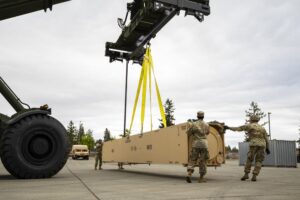The Army unit set to operate the service’s first prototype hypersonic weapon battery will begin receiving live hypersonic missile rounds a year from now, according to the program’s lead official.
Lt. Gen. Neil Thurgood, director of the Army’s Rapid Capabilities and Critical Technologies, told reporters deliveries of the live rounds to provide the unit “a basic load” of missiles will be completed by the end of FY ‘23 to meet the service’s target date to field the first Long Range Hypersonic Weapon (LRHW) operational capability.

“We’ll have met the guidance we were given which was to have an operational offensive unit by the end of FY ‘23,” Thurgood told reporters during a Tuesday briefing at the Association of the United States Army (AUSA) conference. “By the end of FY ‘23, they’ll have all their operational rounds, what we call the basic load of their operational rounds, and they’ll be ready to do what our nation may call upon them to do.”
Last week, the Army announced it had completed fielding of the ground equipment for its first prototype hypersonic weapon battery, minus the live rounds, to the soldiers from the I Corps’ 5th Battalion, 3rd Field Artillery Regiment, 17th Field Artillery Brigade at Joint Base Lewis-McChord in Washington (Defense Daily, Oct. 7).
On Oct. 18, the unit will begin new equipment training on the battery, which consists of four road-mobile, C-17 transportable launchers that can each carry two rounds, a battery operations center and a group of modified trucks and trailers (Defense Daily, Oct. 12).
“We’ll get them trained up on how to use this equipment, how to set up the launchers, how to set up the battery operations center and how to establish a battle position,” Thurgood said.
While the unit is training on the equipment, Thurgood said work will continue on the common glide body and missile stack that will go into making the all-up hypersonic round.
The hypersonic weapon development is a joint effort with the Navy designing the Common Hypersonic Glide Body (C-HGB) and the Army overseeing production.
The Army has previously tapped Lockheed Martin [LMT] to serve as the weapon systems integrator for the LRHW, which will be fired from a truck, while Dynetics [LDOS] is tasked with producing the C-HGB (Defense Daily, Aug. 30, 2019).
Eric Scherff, Lockheed Martin’s vice president of hypersonic strike programs, joined Thurgood in the briefing and told reporters the company’s objective is to produce 24 hypersonic all-up missile rounds per year.
“We’ve come through the critical design of the missile, including the glide body. That’s a milestone we came through about a year ago. And since then, we’ve been building hardware. We’ve begun qualification testing on hardware,” Scherff said, also citing the recent success testing the hypersonic weapon’s first and second stage solid rocket motors. “Those are big milestones that are clear indications that we’re on the right track to get to that flight testing next year. There’s a lot of ground testing still to go but we remain on track.”
Thurgood noted flight testing for the joint hypersonic weapon program will continue through 2022 and 2023, with at least three tests scheduled for next year.